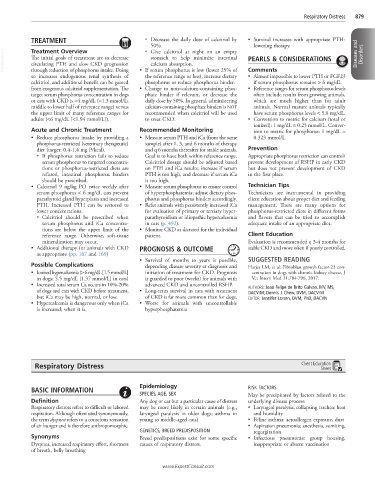Page 1748 - Cote clinical veterinary advisor dogs and cats 4th
P. 1748
Respiratory Distress 879
TREATMENT ○ Decrease the daily dose of calcitriol by • Survival increases with appropriate PTH-
50%. lowering therapy.
Treatment Overview
VetBooks.ir The initial goals of treatment are to decrease stomach to help minimize intestinal PEARLS & CONSIDERATIONS Diseases and Disorders
○ Give calcitriol at night on an empty
calcium absorption.
circulating PTH and slow CKD progression
through reduction of phosphorus intake. Doing
the reference range or less), increase dietary
• Almost impossible to lower PTH or FGF23
so increases endogenous renal synthesis of • If serum phosphorus is low (lower 25% of Comments
calcitriol, and additional benefit can be gained phosphorus or reduce phosphorus binder. if serum phosphorus remains > 6 mg/dL
from exogenous calcitriol supplementation. The • Change to non–calcium-containing phos- • Reference ranges for serum phosphorus levels
target serum phosphorus concentration in dogs phate binder if relevant, or decrease the often include results from growing animals,
or cats with CKD is ≈4 mg/dL (≈1.3 mmol/L; daily dose by 50%. In general, administering which are much higher than for adult
middle to lower half of reference range) versus calcium-containing phosphate binders is NOT animals. Normal mature animals typically
the upper limit of many reference ranges for recommended when calcitriol will be used have serum phosphorus levels < 5.0 mg/dL.
adults (<6 mg/dL [<1.94 mmol/L]). to treat CKD. • Conversion to metric for calcium (total or
ionized): 1 mg/dL = 0.25 mmol/L. Conver-
Acute and Chronic Treatment Recommended Monitoring sion to metric for phosphorus: 1 mg/dL =
• Reduce phosphorus intake by providing a • Measure serum PTH and iCa (from the same 0.323 mmol/L
phosphorus-restricted (veterinary therapeutic) sample) after 1, 3, and 6 months of therapy
diet (target: 0.4-1.4 mg P/kcal). and q 6 months thereafter for stable animals. Prevention
○ If phosphorus restriction fails to reduce Goal is to have both within reference range. Appropriate phosphorus restriction can control/
serum phosphorus to targeted concentra- Calcitriol dosage should be adjusted based prevent development of RSHP in early CKD
tions or phosphorus-restricted diets are on PTH and iCa results: increase if serum but does not prevent development of CKD
refused, intestinal phosphorus binders PTH is too high, and decrease if serum iCa in the first place.
should be prescribed. is too high.
• Calcitriol 9 ng/kg PO twice weekly after • Measure serum phosphorus to ensure control Technician Tips
serum phosphorus < 6 mg/dL can prevent of hyperphosphatemia; adjust dietary phos- Technicians are instrumental in providing
parathyroid gland hyperplasia and increased phorus and phosphorus binders accordingly. client education about proper diet and feeding
PTH. Increased PTH can be restored to • Refer animals with persistently increased iCa management. There are many options for
lower concentrations. for evaluation of primary or tertiary hyper- phosphorus-restricted diets in different forms
○ Calcitriol should be prescribed when parathyroidism or idiopathic hypercalcemia and flavors that can be tried to accomplish
serum phosphorus and iCa concentra- in cats (p. 492). adequate intake of an appropriate diet.
tions are below the upper limit of the • Monitor CKD as dictated for the individual
reference range. Otherwise, soft-tissue patient. Client Education
mineralization may occur. Evaluation is recommended q 3-4 months for
• Additional therapy for animals with CKD PROGNOSIS & OUTCOME stable CKD and more often if poorly controlled.
as appropriate (pp. 167 and 169)
• Survival of months to years is possible, SUGGESTED READING
Possible Complications depending disease severity at diagnosis and Harjes LM, et al: Fibroblast growth factor-23 con-
• Ionized hypercalcemia (> 6 mg/dL [1.5 mmol/L] initiation of treatment for CKD. Prognosis centration in dogs with chronic kidney disease. J
in dogs; 5.5 mg/dL [1.37 mmol/L] in cats) is guarded to poor (weeks) for animals with Vet Intern Med 31:784-790, 2017.
• Increased total serum Ca occurs in 10%-20% advanced CKD and uncontrolled RSHP. AUTHORS: Joao Felipe de Brito Galvao, MV, MS,
of dogs and cats with CKD before treatment, • Long-term survival in cats with treatment DACVIM; Dennis J. Chew, DVM, DACVIM
but iCa may be high, normal, or low. of CKD is far more common than for dogs. EDITOR: Jennifer Larsen, DVM, PhD, DACVN
• Hypercalcemia is dangerous only when iCa • Worse for animals with uncontrollable
is increased; when it is, hyperphosphatemia
Respiratory Distress Client Education
Sheet
Epidemiology RISK FACTORS
BASIC INFORMATION
SPECIES, AGE, SEX May be precipitated by factors related to the
Definition Any dog or cat but a particular cause of distress underlying disease process:
Respiratory distress refers to difficult or labored may be more likely in certain animals (e.g., • Laryngeal paralysis, collapsing trachea: heat
respiration. Although often used synonymously, laryngeal paralysis in older dogs; asthma in and humidity
the term dyspnea refers to a conscious sensation young to middle-aged cats) • Feline asthma: aeroallergen exposure, dust
of air hunger and is therefore anthropomorphic. • Aspiration pneumonia: anesthesia, vomiting,
GENETICS, BREED PREDISPOSITION regurgitation
Synonyms Breed predispositions exist for some specific • Infectious pneumonia: group housing,
Dyspnea, increased respiratory effort, shortness causes of respiratory distress. inappropriate or absent vaccination
of breath, belly breathing
www.ExpertConsult.com

